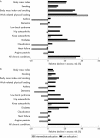Educational differences in mobility: the contribution of physical workload, obesity, smoking and chronic conditions
- PMID: 17435206
- PMCID: PMC2465686
- DOI: 10.1136/jech.2006.048306
Educational differences in mobility: the contribution of physical workload, obesity, smoking and chronic conditions
Abstract
Background: In earlier studies, determinants of socioeconomic gradient in mobility have not been measured comprehensively.
Aim: To assess the contribution of chronic morbidity, obesity, smoking and physical workload to inequalities in mobility.
Methods: This was a cross-sectional study on 2572 persons (76% of a nationally representative sample of the Finnish population aged > or = 55 years). Mobility limitations were measured by self-reports and performance rates.
Results: According to a wide array of self-reported and test-based indicators, persons with a lower level of education showed more mobility limitations than those with a higher level. The age-adjusted ORs for limitations in stair climbing were threefold in the lowest-educational category compared with the highest one (OR 3.3 in men and 2.9 in women for self-reported limitations, and 3.5 in men and 2.2 in women for test-based limitations). When obesity, smoking, work-related physical loading and clinically diagnosed chronic diseases were simultaneously accounted for, the educational differences in stair-climbing limitations vanished or were greatly diminished. In women, obesity contributed most to the differences, followed by a history of physically strenuous work, knee and hip osteoarthritis and cardiovascular diseases. In men, diabetes, work-related physical loading, musculoskeletal diseases, obesity and smoking contributed substantially to the inequalities.
Conclusions: Great educational inequalities exist in various measures of mobility. Common chronic diseases, obesity, smoking and workload appeared to be the main pathways from low education to mobility limitations. General health promotion using methods that also yield good results in the lowest-educational groups is thus a good strategy to reduce the disparities in mobility.
Conflict of interest statement
Competing interests: None.
Similar articles
-
Effect of co-morbidity on the association of high body mass index with walking limitation among men and women aged 55 years and older.Aging Clin Exp Res. 2007 Aug;19(4):277-83. doi: 10.1007/BF03324702. Aging Clin Exp Res. 2007. PMID: 17726357 Clinical Trial.
-
Educational inequalities in general and mental health: differential contribution of physical activity, smoking, alcohol consumption and diet.Eur J Public Health. 2013 Apr;23(2):223-9. doi: 10.1093/eurpub/cks055. Epub 2012 May 10. Eur J Public Health. 2013. PMID: 22577124
-
Self-reported and test-based mobility limitations in a representative sample of Finns aged 30+.Scand J Public Health. 2006;34(4):378-86. doi: 10.1080/14034940500489859. Scand J Public Health. 2006. PMID: 16861188
-
The effects of physical activity and body mass index on cardiovascular, cancer and all-cause mortality among 47 212 middle-aged Finnish men and women.Int J Obes (Lond). 2005 Aug;29(8):894-902. doi: 10.1038/sj.ijo.0802870. Int J Obes (Lond). 2005. PMID: 15724141
-
Social inequality in chronic disease outcomes.Dan Med J. 2014 Nov;61(11):B4943. Dan Med J. 2014. PMID: 25370965 Review.
Cited by
-
Educational disparities in the burden of disability: contributions of disease prevalence and disabling impact.Am J Public Health. 2014 Aug;104(8):e141-8. doi: 10.2105/AJPH.2014.301924. Epub 2014 Jun 12. Am J Public Health. 2014. PMID: 24922134 Free PMC article.
-
Can even experienced orthopaedic surgeons predict who will benefit from surgery when patients present with degenerative meniscal tears? A survey of 194 orthopaedic surgeons who made 3880 predictions.Br J Sports Med. 2020 Mar;54(6):354-359. doi: 10.1136/bjsports-2019-100567. Epub 2019 Aug 1. Br J Sports Med. 2020. PMID: 31371339 Free PMC article.
-
Independent associations of socioeconomic factors with disability and pain in adults with knee osteoarthritis.BMC Musculoskelet Disord. 2013 Oct 17;14:297. doi: 10.1186/1471-2474-14-297. BMC Musculoskelet Disord. 2013. PMID: 24134116 Free PMC article.
-
Associations of educational attainment, occupation and community poverty with knee osteoarthritis in the Johnston County (North Carolina) osteoarthritis project.Arthritis Res Ther. 2011;13(5):R169. doi: 10.1186/ar3492. Epub 2011 Oct 19. Arthritis Res Ther. 2011. PMID: 22011570 Free PMC article.
-
The association of disability and pain with individual and community socioeconomic status in people with hip osteoarthritis.Open Rheumatol J. 2011;5:51-8. doi: 10.2174/1874312901105010051. Epub 2011 Oct 18. Open Rheumatol J. 2011. PMID: 22046207 Free PMC article.
References
-
- WHO International classification of functioning, disability and health. Geneva: World Health Organization, 2001
-
- Ahacic K, Parker M G, Thorslund M. Mobility limitations in the Swedish population from 1968 to 1992: age, gender and social class differences. Aging (Milano) 200012190–198. - PubMed
-
- Sulander T T, Rahkonen O J, Uutela A K. Functional ability in the elderly Finnish population: time period differences and associations, 1985–99. Scand J Public Health 200331100–106. - PubMed
Publication types
MeSH terms
LinkOut - more resources
Full Text Sources
Medical



